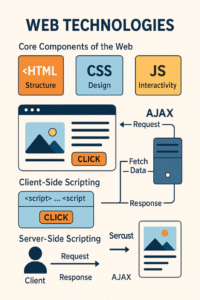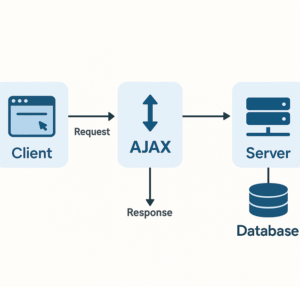Introduction to Web Technologies
Web technologies have reshaped the way we communicate, access information, and build interactive applications. In this tutorial, we will explore the fundamentals of web technologies, trace their evolution, understand how websites work, and learn about both client-side and server-side programming. We will also look at real-world applications and the impact of web technologies on modern life.
What are Web Technologies?
Web technologies refer to the tools, languages, and protocols used to develop and maintain websites and web applications. These technologies form the backbone of the World Wide Web (WWW), enabling browsers and servers to interact and deliver rich digital experiences.
Evolution of Web Technologies
Web 1.0 – Static Web
Only readable content. HTML-based pages with no interaction.
Web 2.0 – Interactive Web
User-generated content, social media, AJAX, and dynamic pages.
Web 3.0 – Semantic Web
AI-driven, decentralized apps, smart contracts, and machine-readable data.
Core Components of the Web
HTML (HyperText Markup Language)
Defines the structure of web pages using tags like <h1>, <p>, <img>, and <a>.
CSS (Cascading Style Sheets)
Responsible for style and layout. Controls colors, fonts, spacing, alignment, and responsiveness.
JavaScript
Adds interactivity to web pages. Used for form validation, dynamic updates, and animations.
Client-Side Scripting
Client-side scripting runs in the user’s browser. It is fast and improves user experience without needing to reload the page.
JavaScript
Handles form validation, animations, and dynamic UI changes.
AJAX (Asynchronous JavaScript and XML)
Allows data to be sent and received in the background. Enables dynamic content updates without refreshing the page.
Server-Side Scripting
Server-side scripting runs on the web server. It processes data, interacts with databases, and generates dynamic content.
PHP (Hypertext Preprocessor)
Used to handle forms, sessions, and databases. Syntax is simple and can be embedded in HTML.
Java Servlets
Java programs that run on a server to handle client requests and return responses.
JSP (JavaServer Pages)
Java-based technology for building dynamic web content using a mix of HTML and Java.
XML and Web Data
What is XML?
Extensible Markup Language used to store and transport structured data.
Processing XML with Java
Java APIs like DOM and SAX are used to read and manipulate XML. Common in data exchange and configuration files.
Applications of Web Technologies
E-commerce Platforms
Used in websites like Amazon and Flipkart for product listings, cart management, and payments.
Social Media
Web technologies enable real-time interaction on platforms like Facebook and Instagram.
Online Education
Web apps power learning platforms for videos, quizzes, and course tracking.
Social and Ethical Considerations
Privacy
Developers must protect user data using secure coding and privacy-focused designs.
Accessibility
Web content should be usable by everyone, including users with disabilities using tools like screen readers.
Conclusion
Web technologies are the foundation of modern digital experiences. From simple web pages to advanced applications, understanding HTML, CSS, JavaScript, PHP, AJAX, Servlets, and XML is essential. As the web evolves, developers and users alike must adapt to new tools, trends, and responsibilities in the digital world.
